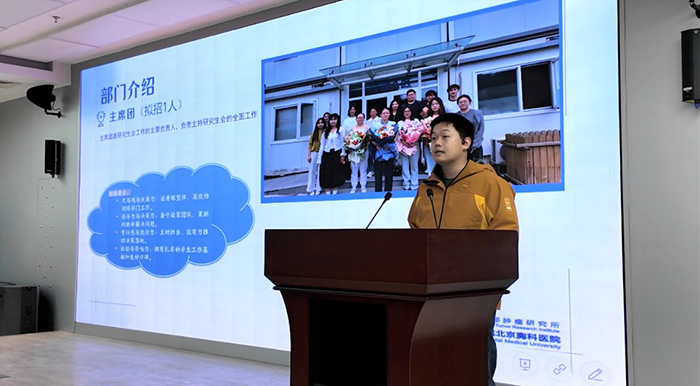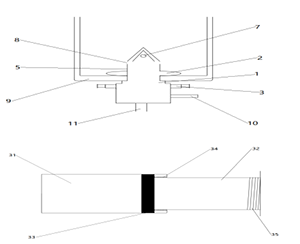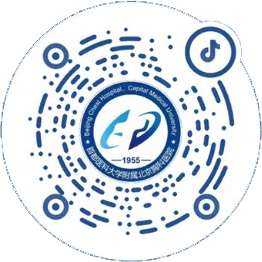2019年
No.6
Medical Abstracts
Keyword: lung cancer
1. Nature. 2019 Mar;567(7749):479-485. doi: 10.1038/s41586-019-1032-7. Epub 2019 Mar 20.
Neoantigen-directed immune escape in lung cancer evolution.
Rosenthal R(1)(2)(3), Cadieux EL(4), Salgado R(5)(6), Bakir MA(3), Moore DA(7),
Hiley CT(1)(3), Lund T(8)(9), Tani? M(10), Reading JL(8)(9), Joshi K(8)(9), Henry
JY(8)(9), Ghorani E(8)(9), Wilson GA(1)(3), Birkbak NJ(1)(3), Jamal-Hanjani M(1),
Veeriah S(1), Szallasi Z(11)(12), Loi S(6), Hellmann MD(13)(14), Feber A(15),
Chain B(16)(17), Herrero J(2), Quezada SA(1)(8)(9), Demeulemeester J(4)(18), Van
Loo P(4)(18), Beck S(10), McGranahan N(19)(20), Swanton C(21)(22); TRACERx
consortium.
Author information:
(1)Cancer Research UK Lung Cancer Centre of Excellence, University College London
Cancer Institute, University College London, London, UK.
(2)Bill Lyons Informatics Centre, University College London Cancer Institute,
University College London, London, UK.
(3)Cancer Evolution and Genome Instability Laboratory, The Francis Crick
Institute, London, UK.
…
The interplay between an evolving cancer and a dynamic immune microenvironment
remains unclear. Here we analyse 258 regions from 88 early-stage, untreated
non-small-cell lung cancers using RNA sequencing and histopathology-assessed
tumour-infiltrating lymphocyte estimates. Immune infiltration varied both between
and within tumours, with different mechanisms of neoantigen presentation
dysfunction enriched in distinct immune microenvironments. Sparsely infiltrated
tumours exhibited a waning of neoantigen editing during tumour evolution,
indicative of historical immune editing, or copy-number loss of previously clonal
neoantigens. Immune-infiltrated tumour regions exhibited ongoing immunoediting,
with either loss of heterozygosity in human leukocyte antigens or depletion of
expressed neoantigens. We identified promoter hypermethylation of genes that
contain neoantigenic mutations as an epigenetic mechanism of immunoediting. Our
results suggest that the immune microenvironment exerts a strong selection
pressure in early-stage, untreated non-small-cell lung cancers that produces
multiple routes to immune evasion, which are clinically relevant and forecast
poor disease-free survival.
DOI: 10.1038/s41586-019-1032-7
PMID: 30894752
2. Nat Med. 2019 Mar;25(3):517-525. doi: 10.1038/s41591-018-0323-0. Epub 2019 Jan
21.
Deciphering the genomic, epigenomic, and transcriptomic landscapes of
pre-invasive lung cancer lesions.
Teixeira VH(1), Pipinikas CP(1)(2), Pennycuick A(1), Lee-Six H(3),
Chandrasekharan D(1), Beane J(4), Morris TJ(2), Karpathakis A(2), Feber A(2),
Breeze CE(2), Ntolios P(1), Hynds RE(1)(5)(6), Falzon M(7), Capitanio A(7),
Carroll B(8), Durrenberger PF(9), Hardavella G(8), Brown JM(1), Lynch AG(10)(11),
Farmery H(10), Paul DS(2), Chambers RC(9), McGranahan N(5), Navani N(1)(8),
Thakrar RM(1)(8), Swanton C(5)(6), Beck S(2), George PJ(8), Spira A(4)(12),
Campbell PJ(3), Thirlwell C(2), Janes SM(13)(14).
Author information:
(1)Lungs for Living Research Centre, UCL Respiratory, University College London,
London, UK.
(2)Research Department of Cancer Biology and Medical Genomics Laboratory, UCL
Cancer Institute, University College London, London, UK.
(3)The Wellcome Trust Sanger Institute, Hinxton, Cambridgeshire, UK.
…
The molecular alterations that occur in cells before cancer is manifest are
largely uncharted. Lung carcinoma in situ (CIS) lesions are the pre-invasive
precursor to squamous cell carcinoma. Although microscopically identical, their
future is in equipoise, with half progressing to invasive cancer and half
regressing or remaining static. The cellular basis of this clinical observation
is unknown. Here, we profile the genomic, transcriptomic, and epigenomic
landscape of CIS in a unique patient cohort with longitudinally monitored
pre-invasive disease. Predictive modeling identifies which lesions will progress
with remarkable accuracy. We identify progression-specific methylation changes on
a background of widespread heterogeneity, alongside a strong chromosomal
instability signature. We observed mutations and copy number changes
characteristic of cancer and chart their emergence, offering a window into early
carcinogenesis. We anticipate that this new understanding of cancer precursor
biology will improve early detection, reduce overtreatment, and foster
preventative therapies targeting early clonal events in lung cancer.
DOI: 10.1038/s41591-018-0323-0
PMID: 30664780
3. Nat Commun. 2019 Mar 27;10(1):1382. doi: 10.1038/s41467-019-09289-5.
FBXW2 suppresses migration and invasion of lung cancer cells via promoting
β-catenin ubiquitylation and degradation.
Yang F(1)(2), Xu J(2), Li H(2), Tan M(2), Xiong X(1), Sun Y(3)(4).
Author information:
(1)Cancer Institute of the Second Affiliated Hospital, and Institute of
Translational Medicine, Zhejiang University School of Medicine, 310029, Hangzhou,
China.
(2)Division of Radiation and Cancer Biology, Departments of Radiation Oncology,
University of Michigan, 4424B MS-1, 1301 Catherine Street, Ann Arbor, MI,
MI48109, USA.
(3)Cancer Institute of the Second Affiliated Hospital, and Institute of
Translational Medicine, Zhejiang University School of Medicine, 310029, Hangzhou,
China. sunyi@umich.edu.
(4)Division of Radiation and Cancer Biology, Departments of Radiation Oncology,
University of Michigan, 4424B MS-1, 1301 Catherine Street, Ann Arbor, MI,
MI48109, USA. sunyi@umich.edu.
FBXW2 inhibits proliferation of lung cancer cells by targeting SKP2 for
degradation. Whether and how FBXW2 regulates tumor invasion and metastasis is
previously unknown. Here, we report that FBXW2 is an E3 ligase for β-catenin.
FBXW2 binds to β-catenin upon EGF-AKT1-mediated phosphorylation on Ser552, and
promotes its ubiquitylation and degradation. FBXW2 overexpression reduces
β-catenin levels and protein half-life, whereas FBXW2 knockdown increases
β-catenin levels, protein half-life and transcriptional activity. Functionally,
FBXW2 overexpression inhibits migration and invasion by blocking transactivation
of MMPs driven by β-catenin, whereas FXBW2 knockdown promotes migration, invasion
and metastasis both in vitro and in vivo lung cancer models. In human lung cancer
specimens, while FBXW2 levels are inversely correlated with β-catenin levels and
lymph-node metastasis, lower FBXW2 coupled with higher β-catenin, predict a worse
patient survival. Collectively, our study demonstrates that FBXW2 inhibits tumor
migration, invasion and metastasis in lung cancer cells by targeting β-catenin
for degradation.
DOI: 10.1038/s41467-019-09289-5
PMCID: PMC6437151
PMID: 30918250 [Indexed for MEDLINE]
4. Am J Respir Crit Care Med. 2019 Mar 21. doi: 10.1164/rccm.201806-1178OC. [Epub
ahead of print]
Driver Mutations in Normal Airway Epithelium Elucidate Spatiotemporal Resolution
of Lung Cancer.
Kadara H(1), Sivakumar S(2)(3), Jakubek Y(2), San Lucas FA(2), Lang W(4),
McDowell T(4), Weber Z(5), Behrens C(6), Davies GE(5), Kalhor N(7), Moran C(8),
El-Zein R(9), Mehran R(10), Swisher SG(10), Wang J(11), Zhang J(12), Fujimoto
J(4), Fowler J(13), Heymach JV(14), Dubinett S(15), Spira AE(16), Ehli EA(5),
Wistuba II(17), Scheet P(2).
Author information:
(1)University of Texas MD Anderson Cancer Center, 4002, Translational Molecular
Pathology, Houston, Texas, United States ; hkadara@mdanderson.org.
(2)University of Texas MD Anderson Cancer Center, Epidemiology, Houston, Texas,
United States.
(3)MD Anderson Cancer Center UTHealth Graduate School of Biomedical Sciences,
Houston, Texas, United States.
…
RATIONALE: Uninvolved normal-appearing airway epithelium has been shown to
exhibit specific mutations characteristic of nearby non-small cell lung cancers
(NSCLCs). Yet, its somatic mutational landscape in early-stage NSCLC patients is
unknown.
OBJECTIVES: To comprehensively survey the somatic mutational architecture of the
normal airway epithelium in early-stage NSCLC patients.
METHODS: Multi-region normal airways, comprising tumor-adjacent small airways,
tumor-distant large airways, nasal epithelium and uninvolved normal lung
(collectively airway field), matched NSCLCs as well as blood cells (n = 498) from
48 patients were interrogated for somatic single nucleotide variants (SNVs) by
deep targeted DNA sequencing and for chromosomal allelic imbalance (AI) events by
genome-wide genotype array profiling. Spatiotemporal relationships between the
airway field and NSCLCs were assessed by phylogenetic analysis.
MEASUREMENTS AND MAIN RESULTS: Genomic airway field carcinogenesis was observed
in 25 cases (52%). The airway field epithelium exhibited a total of 269 somatic
mutations in a large majority of patients (n = 36) including key drivers which
were shared with the NSCLCs. Allele frequencies of these acquired variants were
overall higher in NSCLCs. Integrative analysis of SNVs and AI events revealed
driver genes with shared "two-hit" alterations in the airway field (e.g., TP53,
KRAS, KEAP1, STK11, CDKN2A) as well as those with single hits progressing to two
in the NSCLCs (e.g., PIK3CA, NOTCH1).
CONCLUSIONS: Tumor-adjacent and -distant normal-appearing airway epithelia
exhibit somatic driver alterations that undergo selection-driven clonal expansion
in the NSCLC. These events offer spatiotemporal insights into the development of
NSCLC and, thus, potential targets for early treatment.
DOI: 10.1164/rccm.201806-1178OC
PMID: 30896962
5. J Clin Oncol. 2019 Mar 20:JCO1802236. doi: 10.1200/JCO.18.02236. [Epub ahead of
print]
ALK Resistance Mutations and Efficacy of Lorlatinib in Advanced Anaplastic
Lymphoma Kinase-Positive Non-Small-Cell Lung Cancer.
Shaw AT(1), Solomon BJ(2), Besse B(3), Bauer TM(4), Lin CC(5), Soo RA(6), Riely
GJ(7), Ou SI(8), Clancy JS(9), Li S(10), Abbattista A(11), Thurm H(10), Satouchi
M(12), Camidge DR(13), Kao S(14), Chiari R(15), Gadgeel SM(16), Felip E(17),
Martini JF(10).
Author information:
(1)1 Massachusetts General Hospital, Boston, MA.
(2)2 Peter MacCallum Cancer Centre, Melbourne, Victoria, Australia.
(3)3 Gustave Roussy Cancer Campus, Villejuif, France.
(4)4 Sarah Cannon Cancer Research Institute/Tennessee Oncology PLLC, Nashville,
TN.
…
PURPOSE: Lorlatinib is a potent, brain-penetrant, third-generation anaplastic
lymphoma kinase (ALK)/ROS1 tyrosine kinase inhibitor (TKI) with robust clinical
activity in advanced ALK-positive non-small-cell lung cancer, including in
patients who have failed prior ALK TKIs. Molecular determinants of response to
lorlatinib have not been established, but preclinical data suggest that ALK
resistance mutations may represent a biomarker of response in previously treated
patients.
PATIENTS AND METHODS: Baseline plasma and tumor tissue samples were collected
from 198 patients with ALK-positive non-small-cell lung cancer from the
registrational phase II study of lorlatinib. We analyzed plasma DNA for ALK
mutations using Guardant360. Tumor tissue DNA was analyzed using an ALK
mutation-focused next-generation sequencing assay. Objective response rate,
duration of response, and progression-free survival were evaluated according to
ALK mutation status.
RESULTS: Approximately one quarter of patients had ALK mutations detected by
plasma or tissue genotyping. In patients with crizotinib-resistant disease, the
efficacy of lorlatinib was comparable among patients with and without ALK
mutations using plasma or tissue genotyping. In contrast, in patients who had
failed 1 or more second-generation ALK TKIs, objective response rate was higher
among patients with ALK mutations (62% v 32% [plasma]; 69% v 27% [tissue]).
Progression-free survival was similar in patients with and without ALK mutations
on the basis of plasma genotyping (median, 7.3 months v 5.5 months; hazard ratio,
0.81) but significantly longer in patients with ALK mutations identified by
tissue genotyping (median, 11.0 months v 5.4 months; hazard ratio, 0.47).
CONCLUSION: In patients who have failed 1 or more second-generation ALK TKIs,
lorlatinib shows greater efficacy in patients with ALK mutations compared with
patients without ALK mutations. Tumor genotyping for ALK mutations after failure
of a second-generation TKI may identify patients who are more likely to derive
clinical benefit from lorlatinib.
DOI: 10.1200/JCO.18.02236
PMID: 30892989
6. Nano Lett. 2019 Apr 10;19(4):2231-2242. doi: 10.1021/acs.nanolett.8b04309. Epub
2019 Mar 21.
Optimized Bexarotene Aerosol Formulation Inhibits Major Subtypes of Lung Cancer
in Mice.
Zhang Q, Lee SB, Chen X, Stevenson ME(1), Pan J, Xiong D, Zhou Y, Miller MS(2),
Lubet RA(2), Wang Y, Mirza SP(3), You M.
Author information:
(1)Department of Psychology , University of Wisconsin , Milwaukee , Wisconsin
53211 , United States.
(2)Division of Cancer Prevention , National Cancer Institute , Rockville ,
Maryland 20850 , United States.
(3)Department of Chemistry and Biochemistry , University of Wisconsin , Milwaukee
, Wisconsin 53211 , United States.
Bexarotene has shown inhibition of lung and mammary gland tumorigenesis in
preclinical models and in clinical trials. The main side effects of orally
administered bexarotene are hypertriglyceridemia and hypercholesterolemia. We
previously demonstrated that aerosolized bexarotene administered by nasal
inhalation has potent chemopreventive activity in a lung adenoma preclinical
model without causing hypertriglyceridemia. To facilitate its future clinical
translation, we modified the formula of the aerosolized bexarotene with a
clinically relevant solvent system. This optimized aerosolized bexarotene
formulation was tested against lung squamous cell carcinoma mouse model and lung
adenocarcinoma mouse model and showed significant chemopreventive effect. This
new formula did not cause visible signs of toxicity and did not increase plasma
triglycerides or cholesterol. This aerosolized bexarotene was evenly distributed
to the mouse lung parenchyma, and it modulated the microenvironment in vivo by
increasing the tumor-infiltrating T cell population. RNA sequencing of the lung
cancer cell lines demonstrated that multiple pathways are altered by bexarotene.
For the first time, these studies demonstrate a new, clinically relevant
aerosolized bexarotene formulation that exhibits preventive efficacy against the
major subtypes of lung cancer. This approach could be a major advancement in lung
cancer prevention for high risk populations, including former and present
smokers.
DOI: 10.1021/acs.nanolett.8b04309
PMID: 30873838
7. J Exp Med. 2019 Apr 1;216(4):982-1000. doi: 10.1084/jem.20180870. Epub 2019 Mar
14.
Secreted PD-L1 variants mediate resistance to PD-L1 blockade therapy in non-small
cell lung cancer.
Gong B(1)(2), Kiyotani K(3), Sakata S(4), Nagano S(5)(6), Kumehara S(5)(6), Baba
S(4), Besse B(7)(8), Yanagitani N(9), Friboulet L(7), Nishio M(9), Takeuchi
K(4)(10), Kawamoto H(5), Fujita N(1)(2), Katayama R(11).
Author information:
(1)Cancer Chemotherapy Center, Japanese Foundation for Cancer Research, Tokyo,
Japan.
(2)Department of Computational Biology and Medical Sciences, Graduate School of
Frontier Sciences, The University of Tokyo, Chiba, Japan.
(3)Immunopharmacogenomics Group, Cancer Precision Medicine Center, Japanese
Foundation for Cancer Research, Tokyo, Japan.
…
Immune checkpoint blockade against programmed cell death 1 (PD-1) and its ligand
PD-L1 often induces durable tumor responses in various cancers, including
non-small cell lung cancer (NSCLC). However, therapeutic resistance is
increasingly observed, and the mechanisms underlying anti-PD-L1 (aPD-L1) antibody
treatment have not been clarified yet. Here, we identified two unique secreted
PD-L1 splicing variants, which lacked the transmembrane domain, from
aPD-L1-resistant NSCLC patients. These secreted PD-L1 variants worked as "decoys"
of aPD-L1 antibody in the HLA-matched coculture system of iPSC-derived CD8 T
cells and cancer cells. Importantly, mixing only 1% MC38 cells with secreted
PD-L1 variants and 99% of cells that expressed wild-type PD-L1 induced resistance
to PD-L1 blockade in the MC38 syngeneic xenograft model. Moreover, anti-PD-1
(aPD-1) antibody treatment overcame the resistance mediated by the secreted PD-L1
variants. Collectively, our results elucidated a novel resistant mechanism of
PD-L1 blockade antibody mediated by secreted PD-L1 variants.
© 2019 Gong et al.
DOI: 10.1084/jem.20180870
PMCID: PMC6446862
PMID: 30872362
8. J Clin Oncol. 2019 Mar 1;37(7):537-546. doi: 10.1200/JCO.18.00149. Epub 2019 Jan
8.
Updated Analysis of KEYNOTE-024: Pembrolizumab Versus Platinum-Based Chemotherapy
for Advanced Non-Small-Cell Lung Cancer With PD-L1 Tumor Proportion Score of 50%
or Greater.
Reck M(1), Rodríguez-Abreu D(2), Robinson AG(3), Hui R(4), Cs?szi T(5), Fülöp
A(6), Gottfried M(7), Peled N(8), Tafreshi A(9), Cuffe S(10), O'Brien M(11), Rao
S(12), Hotta K(13), Vandormael K(14), Riccio A(15), Yang J(15), Pietanza MC(15),
Brahmer JR(16).
Author information:
(1)Lung Clinic Grosshansdorf, Airway Research Center North, Grosshansdorf,
Germany.
(2)Complejo Hospitalario Universitario Insular Materno-Infantil de Gran Canaria,
Universidad de Las Palmas de Gran Canaria, Las Palmas de Gran Canaria, Spain.
(3)Cancer Centre of Southeastern Ontario at Kingston General Hospital, Kingston,
Ontario, Canada.
…
PURPOSE: In the randomized, open-label, phase III KEYNOTE-024 study,
pembrolizumab significantly improved progression-free survival and overall
survival (OS) compared with platinum-based chemotherapy in patients with
previously untreated advanced non-small-cell lung cancer (NSCLC) with a
programmed death ligand 1 tumor proportion score of 50% or greater and without
EGFR/ALK aberrations. We report an updated OS and tolerability analysis,
including analyses adjusting for potential bias introduced by crossover from
chemotherapy to pembrolizumab.
PATIENTS AND METHODS: Patients were randomly assigned to pembrolizumab 200 mg
every 3 weeks (for up to 2 years) or investigator's choice of platinum-based
chemotherapy (four to six cycles). Patients assigned to chemotherapy could cross
over to pembrolizumab upon meeting eligibility criteria. The primary end point
was progression-free survival; OS was an important key secondary end point.
Crossover adjustment analysis was done using the following three methods:
simplified two-stage method, rank-preserving structural failure time, and inverse
probability of censoring weighting.
RESULTS: Three hundred five patients were randomly assigned (pembrolizumab, n =
154; chemotherapy, n = 151). At data cutoff (July 10, 2017; median follow-up,
25.2 months), 73 patients in the pembrolizumab arm and 96 in the chemotherapy arm
had died. Median OS was 30.0 months (95% CI, 18.3 months to not reached) with
pembrolizumab and 14.2 months (95% CI, 9.8 to 19.0 months) with chemotherapy
(hazard ratio, 0.63; 95% CI, 0.47 to 0.86). Eighty-two patients assigned to
chemotherapy crossed over on study to receive pembrolizumab. When adjusted for
crossover using the two-stage method, the hazard ratio for OS for pembrolizumab
versus chemotherapy was 0.49 (95% CI, 0.34 to 0.69); results using
rank-preserving structural failure time and inverse probability of censoring
weighting were similar. Treatment-related grade 3 to 5 adverse events were less
frequent with pembrolizumab compared with chemotherapy (31.2% v 53.3%,
respectively).
CONCLUSION: With prolonged follow-up, first-line pembrolizumab monotherapy
continues to demonstrate an OS benefit over chemotherapy in patients with
previously untreated, advanced NSCLC without EGFR/ALK aberrations, despite
crossover from the control arm to pembrolizumab as subsequent therapy.
DOI: 10.1200/JCO.18.00149
PMID: 30620668
9. J Clin Invest. 2019 Mar 1;129(3):1211-1228. doi: 10.1172/JCI123319. Epub 2019 Feb 11.
PARP inhibition enhances tumor cell-intrinsic immunity in ERCC1-deficient
non-small cell lung cancer.
Chabanon RM(1)(2)(3)(4), Muirhead G(3), Krastev DB(3)(4), Adam J(2), Morel
D(1)(2), Garrido M(2), Lamb A(5), Hénon C(1)(2), Dorvault N(2), Rouanne M(1)(6),
Marlow R(7), Bajrami I(3)(4), Cardeñosa ML(3)(4)(8), Konde A(3)(4), Besse
B(1)(9), Ashworth A(10), Pettitt SJ(3)(4), Haider S(3), Marabelle A(6)(11), Tutt
AN(3)(7), Soria JC(1), Lord CJ(3)(4), Postel-Vinay S(1)(2)(11).
Author information:
(1)Université Paris Saclay, Université Paris-Sud, Faculté de médicine, Le Kremlin
Bicêtre, Paris, France.
(2)ATIP-Avenir group, Inserm U981, Gustave Roussy, Villejuif, France.
(3)The Breast Cancer Now Toby Robins Breast Cancer Research Centre and.
(4)CRUK Gene Function Laboratory, The Institute of Cancer Research, London,
United Kingdom.
…
The cyclic GMP-AMP synthase/stimulator of IFN genes (cGAS/STING) pathway detects
cytosolic DNA to activate innate immune responses. Poly(ADP-ribose) polymerase
inhibitors (PARPi) selectively target cancer cells with DNA repair deficiencies
such as those caused by BRCA1 mutations or ERCC1 defects. Using isogenic cell
lines and patient-derived samples, we showed that ERCC1-defective non-small cell
lung cancer (NSCLC) cells exhibit an enhanced type I IFN transcriptomic signature
and that low ERCC1 expression correlates with increased lymphocytic infiltration.
We demonstrated that clinical PARPi, including olaparib and rucaparib, have
cell-autonomous immunomodulatory properties in ERCC1-defective NSCLC and
BRCA1-defective triple-negative breast cancer (TNBC) cells. Mechanistically,
PARPi generated cytoplasmic chromatin fragments with characteristics of
micronuclei; these were found to activate cGAS/STING, downstream type I IFN
signaling, and CCL5 secretion. Importantly, these effects were suppressed in
PARP1-null TNBC cells, suggesting that this phenotype resulted from an on-target
effect of PARPi on PARP1. PARPi also potentiated IFN-γ-induced PD-L1 expression
in NSCLC cell lines and in fresh patient tumor cells; this effect was enhanced in
ERCC1-deficient contexts. Our data provide a preclinical rationale for using
PARPi as immunomodulatory agents in appropriately molecularly selected
populations.
DOI: 10.1172/JCI123319
PMCID: PMC6391116 [Available on 2019-06-01]
PMID: 30589644
10. Autophagy. 2019 Mar;15(3):391-406. doi: 10.1080/15548627.2018.1511503. Epub 2018 Sep 6.
Identification of compound CA-5f as a novel late-stage autophagy inhibitor with
potent anti-tumor effect against non-small cell lung cancer.
Zhang L(1), Qiang P(1), Yu J(1), Miao Y(1), Chen Z(1), Qu J(1), Zhao Q(1), Chen
Z(1), Liu Y(1), Yao X(1), Liu B(1), Cui L(1), Jing H(1), Sun G(2).
Author information:
(1)a College of Bioengineering , Henan University of Technology , Zhengzhou ,
China.
(2)b College of Chemistry and Chemical Engineering , Henan University of
Technology , Zhengzhou , China.
Currently, particular focus is placed on the implication of autophagy in a
variety of human diseases, including cancer. Discovery of small-molecule
modulators of autophagy as well as their potential use as anti-cancer therapeutic
agents would be of great significance. To this end, a series of curcumin analogs
previously synthesized in our laboratory were screened. Among these compounds,
(3E,5E)-3-(3,4-dimethoxybenzylidene)-5-[(1H-indol-3-yl)methylene]-1-methylpiperid in-4-one (CA-5f) was identified as a potent late-stage macroautophagy/autophagy
inhibitor via inhibiting autophagosome-lysosome fusion. We found that CA-5f
neither impaired the hydrolytic function nor the quantity of lysosomes. Use of an
isobaric tag for relative and absolute quantitation (iTRAQ)-based proteomic
screen in combination with bioinformatics analysis suggested that treatment of
human umbilical vein endothelial cells (HUVECs) with CA-5f for 1 h suppressed the
levels of cytoskeletal proteins and membrane traffic proteins. Subsequent studies
showed that CA-5f exhibited strong cytotoxicity against A549 non-small cell lung
cancer (NSCLC) cells, but low cytotoxicity to normal human umbilical vein
endothelial cells (HUVECs), by increasing mitochondrial-derived reactive oxygen
species (ROS) production. Moreover, CA-5f effectively suppressed the growth of
A549 lung cancer xenograft as a single agent with an excellent tolerance in vivo.
Results from western blot, immunofluorescence, and TdT-mediated dUTP nick end
labeling (TUNEL) assays showed that CA-5f inhibited autophagic flux, induced
apoptosis, and did not affect the level of CTSB (cathepsin B) and CTSD (cathepsin
D) in vivo, which were consistent with the in vitro data. Collectively, these
results demonstrated that CA-5f is a novel late-stage autophagy inhibitor with
potential clinical application for NSCLC therapy. Abbreviations: 3-MA,
3-methyladenine; ANXA5, annexin A5; ATG, autophagy related; CA-5f,
(3E,5E)-3-(3,4-dimethoxybenzylidene)-5-[(1H-indol-3-yl)methylene]-1-methylpiperid in-4-one; CQ, chloroquine; CTSB, cathepsin B; CTSD, cathepsin D; DMSO, dimethyl
sulfoxide; DNM2, dynamin 2; EBSS, Earle's balanced salt solution; GFP, green
fluorescent protein; HCQ, hydroxyl CQ; HEK293, human embryonic kidney 293; HUVEC,
human umbilical vein endothelial cells; LAMP1, lysosomal associated membrane
protein 1; LC-MS/MS, liquid chromatography coupled to tandem mass spectrometry;
LDH, lactic acid dehydrogenase; LMO7, LIM domain 7; MAP1LC3B/LC3B, microtubule
associated protein 1 light chain 3 beta; NAC, N-acetyl cysteine; MYO1E, myosin
IE; NSCLC, non-small cell lung cancer; PARP1, poly(ADP-ribose) polymerase 1; PI,
propidium iodide; RFP, red fluorescent protein; ROS, reactive oxygen species;
SQSTM1, sequestosome 1; TUNEL, terminal deoxynucleotidyl transferase-mediated
dUTP nick-end labeling.
DOI: 10.1080/15548627.2018.1511503
PMCID: PMC6351124 [Available on 2019-09-06]
PMID: 30145925
11. Ann Surg. 2019 Mar 26. doi: 10.1097/SLA.0000000000003231. [Epub ahead of print]
A National Analysis of Short-term Outcomes and Long-term Survival Following
Thoracoscopic Versus Open Lobectomy for Clinical Stage II Non-Small-Cell Lung
Cancer.
Yang CJ(1), Kumar A(2), Deng JZ(1), Raman V(2), Lui NS(1), D'Amico TA(2), Berry
MF(1)(3).
Author information:
(1)Department of Cardiothoracic Surgery, Stanford University Medical Center,
Stanford, CA.
(2)Division of Thoracic Surgery, Department of Surgery, Duke University Medical
Center, Durham, NC.
(3)VA Palo Alto Health Care System, Palo Alto, CA.
MINI: In this national analysis, thoracoscopic lobectomy was associated with
shorter hospital stay and no significant difference in long-term survival when
compared to open lobectomy for cT1-2N1M0 non-small-cell lung cancer (NSCLC).
These results suggest that thoracoscopic techniques are feasible in the treatment
of stage II (cN1) NSCLC.OBJECTIVE: To compare outcomes after open versus
thoracoscopic (VATS) lobectomy for clinical stage II (cN1) non-small-cell lung
cancer (NSCLC).
BACKGROUND: There have been no published studies evaluating the impact of a VATS
approach to lobectomy for N1 NSCLC on short-term outcomes and survival.
METHODS: Outcomes of patients with clinical T1-2, N1, M0 NSCLC who underwent
lobectomy without induction therapy in the National Cancer Data Base (2010-2012)
were evaluated using multivariable Cox proportional hazards modeling and
propensity score-matched analysis.
RESULTS: Median follow-up of 1559 lobectomies (1204 open and 355 VATS) was 43.2
months. The VATS approach was associated with a shorter median hospitalization (5
vs 6 d, P < 0.001) than the open approach. There were no significant differences
between the VATS and open approach with regard to nodal upstaging (12.0% vs
10.5%, P = 0.41), 30-day mortality (2.3% vs 3.1%, P = 0.31), and overall survival
(5-yr survival: 48.6% vs 48.7%, P = 0.76; multivariable-adjusted HR for VATS
approach: 1.08, 95% CI: 0.90-1.30, P = 0.39). A propensity score-matched analysis
of 334 open and 334 VATS patients who were well matched by 14 common prognostic
covariates, including tumor size, and comorbidities, continued to show no
significant differences in nodal upstaging, 30-day mortality, and 5-year survival
between the VATS and open groups.
CONCLUSION: In this national analysis, VATS lobectomy was used in the minority of
N1 NSCLC cases but was associated with shorter hospitalization and similar nodal
upstaging rates, 30-day mortality, and long-term survival when compared to open
lobectomy. These findings suggest thoracoscopic techniques are feasible for the
treatment of stage II (cN1) NSCLC.
DOI: 10.1097/SLA.0000000000003231
PMID: 30946089
12. Cancer Res. 2019 Mar 22. pii: canres.2156.2018. doi:
10.1158/0008-5472.CAN-18-2156. [Epub ahead of print]
Elevated heme synthesis and uptake underpin intensified oxidative metabolism and
tumorigenic functions in non-small cell lung cancer cells.
Sohoni S(1), Ghosh P(1), Wang T(2), Kalainayakan SP(1), Vidal C(2), Dey S(1),
Konduri PC(1), Zhang L(3).
Author information:
(1)Biological Sciences, The University of Texas at Dallas.
(2)Department of Biological Sciences, University of Texas at Dallas.
(3)Biological Sciences, The University of Texas at Dallas li.zhang@utdallas.edu.
Tumors of human non-small cell lung cancer (NSCLC) are heterogeneous but exhibit
elevated glycolysis and glucose oxidation relative to benign lung. Heme is a
central molecule for oxidative metabolism and ATP generation via mitochondrial
oxidative phosphorylation (OXPHOS). Here we showed that levels of heme synthesis
and uptake, mitochondrial heme, oxygen-utilizing hemoproteins, oxygen
consumption, ATP generation, and key mitochondrial biogenesis regulators were
enhanced in NSCLC cells relative to non-tumorigenic cells. Likewise, proteins and
enzymes relating to heme and mitochondrial functions were upregulated in human
NSCLC tissues relative to normal tissues. Engineered heme-sequestering peptides
(HSP) reduced heme uptake, intracellular heme levels, and tumorigenic functions
of NSCLC cells. Addition of heme largely reversed the effect of HSP on
tumorigenic functions. Furthermore, HSP2 significantly suppressed the growth of
human NSCLC xenograft tumors in mice. HSP2-treated tumors exhibited reduced
oxygen consumption rates and ATP levels. To further verify the importance of heme
in promoting tumorigenicity, we generated NSCLC cell lines with increased heme
synthesis or uptake by overexpressing either the rate-limiting heme synthesis
enzyme ALAS1 or uptake protein SLC48A1, respectively. These cells exhibited
enhanced migration and invasion and accelerated tumor growth in mice. Notably,
tumors formed by cells with increased heme synthesis or uptake also displayed
elevated oxygen consumption rates and ATP levels. These data show that elevated
heme flux and function underlie enhanced OXPHOS and tumorigenicity of NSCLC
cells. Targeting heme flux and function offers a potential strategy for
developing therapies for lung cancer.
Copyright 2019, American Association for Cancer Research.
DOI: 10.1158/0008-5472.CAN-18-2156
PMID: 30902795
13. Br J Pharmacol. 2019 Mar 1. doi: 10.1111/bph.14652. [Epub ahead of print]
Diosmetin induces apoptosis and enhances the chemotherapeutic efficacy of
paclitaxel in non-small cell lung cancer cells via Nrf2 inhibition.
Chen X(1)(2)(3), Wu Q(1)(2)(3), Chen Y(1)(2)(3), Zhang J(1)(2)(3), Li H(1)(2)(3),
Yang Z(1)(2)(3), Yang Y(1)(2)(3), Deng Y(1)(2)(3), Zhang L(2)(3)(4), Liu
B(1)(2)(3).
Author information:
(1)Department of Clinical pharmacy, School of Pharmacy, Guangdong Pharmaceutical
University, Guangzhou, 510006, China.
(2)Guangzhou key laboratory of construction and application of new drug screening
model systems, Guangdong Pharmaceutical University, Guangzhou, 510006, China.
(3)Key Laboratory of New Drug Discovery and Evaluation of ordinary universities
of Guangdong province, Guangdong Pharmaceutical University, Guangzhou, 510006,
China.
(4)The Center for Drug Research and Development, Guangdong Pharmaceutical
University, Guangzhou, 510006, China.
BACKGROUND AND PURPOSE: Non-small cell lung cancer (NSCLC) accounts for up to
80-85% of all lung cancers with a disappointing prognosis. Flavonoids exert
anti-cancer properties, mostly involving stimulation of ROS production without
significant toxicity to normal cells. This study was aimed to delineate the
effect of diosmetin, a natural flavonoid, on NSCLC cells and the ability to
enhance the anti-tumour activity of paclitaxel.
EXPERIMENTAL APPROACH: NSCLC cells, normal cell lines HLF-1 and BEAS-2B, as well
as immunodeficient mice were chosen as a model to study the treatment effects.
Changes in cell viability, apoptosis and ROS were analyzed by MTT assay, flow
cytometry assay and fluorescent probe DCFH-DA. Molecule expression was determined
by western blotting and real-time RT-PCR. Xenografted tumors, spleens and other
vital organs were harvested and subjected to growth inhibition measurement,
histological and immunohistochemical analyses.
KEY RESULTS: Diosmetin induced selective apoptotic death in NSCLC cells, but
spared normal cells, via ROS accumulation. Diosmetin induced ROS production in
NSCLC cells probably via reducing Nrf2 stability through disruption of
PI3K/Akt/GSK-3 pathway. The in vitro and in vivo xenograft studies showed that
combined treatment of diosmetin and paclitaxel synergistically suppressed NSCLC
cells. Histological analysis of vital organs showed no obvious toxicity of
diosmetin, which matched our in vitro findings.
CONCLUSIONS AND IMPLICATIONS: Diosmetin selectively induces apoptosis and
enhances the paclitaxel efficacy in NSCLC cells via ROS accumulation through
disruption of PI3K/Akt/GSK-3尾/Nrf2 pathway. Therefore, diosmetin may be a
promising candidate for NSCLC adjuvant treatment.
This article is protected by copyright. All rights reserved.
DOI: 10.1111/bph.14652
PMID: 30825187
14. Cancer Res. 2019 Mar 15;79(6):1204-1213. doi: 10.1158/0008-5472.CAN-18-1082. Epub 2018 Dec 20.
Early Noninvasive Detection of Response to Targeted Therapy in Non-Small Cell
Lung Cancer.
Phallen J(1), Leal A(1), Woodward BD(2), Forde PM(1), Naidoo J(1), Marrone KA(1),
Brahmer JR(1), Fiksel J(1), Medina JE(1), Cristiano S(1), Palsgrove DN(1), Gocke
CD(1), Bruhm DC(1), Keshavarzian P(2), Adleff V(1), Weihe E(2), Anagnostou V(1),
Scharpf RB(1), Velculescu VE(3), Husain H(4).
Author information:
(1)The Sidney Kimmel Comprehensive Cancer Center, Johns Hopkins University School
of Medicine, Baltimore, Maryland.
(2)Division of Hematology and Oncology, Moores Cancer Center, University of
California, San Diego, La Jolla, California.
(3)The Sidney Kimmel Comprehensive Cancer Center, Johns Hopkins University School
of Medicine, Baltimore, Maryland. velculescu@jhmi.edu hhusain@ucsd.edu.
(4)Division of Hematology and Oncology, Moores Cancer Center, University of
California, San Diego, La Jolla, California. velculescu@jhmi.edu
hhusain@ucsd.edu.
With the advent of precision oncology, there is an urgent need to develop
improved methods for rapidly detecting responses to targeted therapies. Here, we
have developed an ultrasensitive measure of cell-free tumor load using targeted
and whole-genome sequencing approaches to assess responses to tyrosine kinase
inhibitors in patients with advanced lung cancer. Analyses of 28 patients treated
with anti-EGFR or HER2 therapies revealed a bimodal distribution of cell-free
circulating tumor DNA (ctDNA) after therapy initiation, with molecular responders
having nearly complete elimination of ctDNA (>98%). Molecular nonresponders
displayed limited changes in ctDNA levels posttreatment and experienced
significantly shorter progression-free survival (median 1.6 vs. 13.7 months, P <
0.0001; HR = 66.6; 95% confidence interval, 13.0-341.7), which was detected on
average 4 weeks earlier than CT imaging. ctDNA analyses of patients with
radiographic stable or nonmeasurable disease improved prediction of clinical
outcome compared with CT imaging. These analyses provide a rapid approach for
evaluating therapeutic response to targeted therapies and have important
implications for the management of patients with cancer and the development of
new therapeutics.Significance: Cell-free tumor load provides a novel approach for
evaluating longitudinal changes in ctDNA during systemic treatment with tyrosine
kinase inhibitors and serves an unmet clinical need for real-time, noninvasive
detection of tumor response to targeted therapies before radiographic
assessment.See related commentary by Zou and Meyerson, p. 1038.
2018 American Association for Cancer Research.
DOI: 10.1158/0008-5472.CAN-18-1082
PMCID: PMC6481620
PMID: 30573519
15. Cancer Res. 2019 Mar 15;79(6):1214-1225. doi: 10.1158/0008-5472.CAN-18-1127. Epub 2018 Dec 12.
Dynamics of Tumor and Immune Responses during Immune Checkpoint Blockade in
Non-Small Cell Lung Cancer.
Anagnostou V(#)(1)(2), Forde PM(#)(3)(2), White JR(3), Niknafs N(3), Hruban C(3),
Naidoo J(3)(2), Marrone K(3)(2), Sivakumar IKA(3)(4)(5), Bruhm DC(3), Rosner
S(6), Phallen J(3), Leal A(3), Adleff V(3), Smith KN(3)(2), Cottrell TR(3)(7),
Rhymee L(3), Palsgrove DN(3), Hann CL(3), Levy B(3), Feliciano J(3), Georgiades
C(8), Verde F(8), Illei P(3)(2)(7), Li QK(3)(7), Gabrielson E(3)(7), Brock MV(9),
Isbell JM(10), Sauter JL(11), Taube J(3)(2)(7), Scharpf RB(3), Karchin R(3)(4),
Pardoll DM(3)(2), Chaft JE(12), Hellmann MD(12), Brahmer JR(3)(2), Velculescu
VE(1)(2)(4).
Author information:
(1)The Sidney Kimmel Comprehensive Cancer Center, Johns Hopkins University School
of Medicine, Baltimore, Maryland. vanagno1@jhmi.edu velculescu@jhmi.edu.
(2)The Bloomberg-Kimmel Institute for Cancer Immunotherapy, Johns Hopkins
University School of Medicine, Baltimore, Maryland.
(3)The Sidney Kimmel Comprehensive Cancer Center, Johns Hopkins University School
of Medicine, Baltimore, Maryland.
(4)Institute for Computational Medicine, Johns Hopkins University, Baltimore,
Maryland.
…
Despite the initial successes of immunotherapy, there is an urgent clinical need
for molecular assays that identify patients more likely to respond. Here, we
report that ultrasensitive measures of circulating tumor DNA (ctDNA) and T-cell
expansion can be used to assess responses to immune checkpoint blockade in
metastatic lung cancer patients (N = 24). Patients with clinical response to
therapy had a complete reduction in ctDNA levels after initiation of therapy,
whereas nonresponders had no significant changes or an increase in ctDNA levels.
Patients with initial response followed by acquired resistance to therapy had an
initial drop followed by recrudescence in ctDNA levels. Patients without a
molecular response had shorter progression-free and overall survival compared
with molecular responders [5.2 vs. 14.5 and 8.4 vs. 18.7 months; HR 5.36; 95%
confidence interval (CI), 1.57-18.35; P = 0.007 and HR 6.91; 95% CI, 1.37-34.97;
P = 0.02, respectively], which was detected on average 8.7 weeks earlier and was
more predictive of clinical benefit than CT imaging. Expansion of T cells,
measured through increases of T-cell receptor productive frequencies, mirrored
ctDNA reduction in response to therapy. We validated this approach in an
independent cohort of patients with early-stage non-small cell lung cancer (N =
14), where the therapeutic effect was measured by pathologic assessment of
residual tumor after anti-PD1 therapy. Consistent with our initial findings,
early ctDNA dynamics predicted pathologic response to immune checkpoint blockade.
These analyses provide an approach for rapid determination of therapeutic
outcomes for patients treated with immune checkpoint inhibitors and have
important implications for the development of personalized immune targeted
strategies.Significance: Rapid and sensitive detection of circulating tumor DNA
dynamic changes and T-cell expansion can be used to guide immune targeted therapy
for patients with lung cancer.See related commentary by Zou and Meyerson, p.
1038.
2018 American Association for Cancer Research.
DOI: 10.1158/0008-5472.CAN-18-1127
PMCID: PMC6432636
PMID: 30541742









.jpg)
















